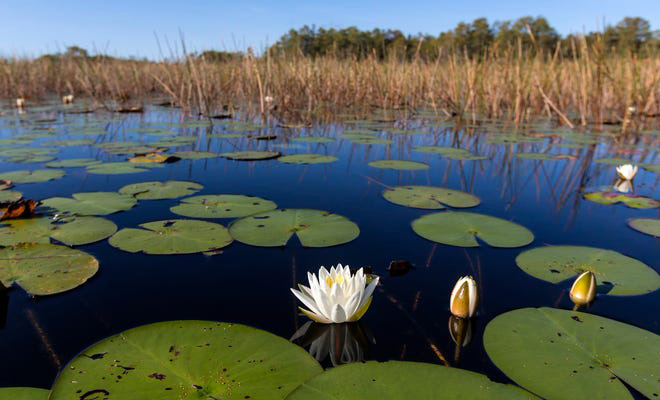
The City of West Palm Beach shut down taps flowing into its main supply of drinking water after finding algae in canals coming from Lake Okeechobee.
Poonam Kalkat, the city’s director of public utilities, said the Grassy Waters Preserve, which also provides water for the Town of Palm Beach, needed to be protected from potential harmful algae blooms, even though the supplemental lake water was buoying the preserve until the wet season arrives.
With water levels dropping in the preserve, there is also a risk the long-suffering Loxahatchee River won’t get the freshwater it needs to fight back invasions of saltwater lethal to native cypress trees that have died in slow motion since human development so altered the watershed.
The Loxahatchee River is South Florida’s only nationally recognized wild and scenic river.
“We are working hard to make sure that while we meet all the needs of the City of West Palm Beach residents, we are also trying to supply water to the Loxahatchee,” Kalkat said in a Water Resources Task Force meeting last week.
A similar situation happened in 2020 when water levels in Grassy Waters dropped too low to supply the Loxahatchee River. At the same time, Lake Okeechobee was also low – 11.03 feet above sea level on May 15 – but a special agreement was made with the South Florida Water Management District to funnel water to the river until the rains came.

This year, Lake Okeechobee is flush with water at nearly 14 feet on Thursday, but algae is the concern.
“We certainly have more water to deliver this year than we did last year if we need to, but now we have water quality issues,” said South Florida Water Management District governing board member Jay Steinle during the April 29 task force meeting. “Prior to that, we should have, and could have, been delivering supplemental flows to the river, because every year the degradation of the river is getting worse.”
The algae found by city officials in the L-8 canal from Lake Okeechobee is growing in patches throughout Palm Beach County waterways and in the lake. Kalkat said she didn’t know if the L-8 algae contained toxins, and no tests in the area are showing on the state’s algal bloom monitoring website.

In late March, the Florida Department of Environmental Protection notified the state health department in Palm Beach County that water samples taken in the C-51 canal upstream of where the releases reach the Lake Worth Lagoon were tainted with blue-green algae and low levels of the toxin microcystin.
Last month, an algae bloom at the Pahokee Marina tested 100 times more toxic than what is considered safe for humans and triggered an emergency cleanup effort spearheaded by the water management district.
Lake Worth Waterkeeper Reynaldo Diaz said cyanobacteria blooms – also known as blue-green algae – have also been spotted in three spillways that lead to the C-51 and in the M canal, which channels water from the L-8 to Grassy Waters.
“There’s been so much political theater over the Pahokee Marina and they completely ignore the true extent (of the algae). They’re going to need a bigger vacuum,” he posted on the waterkeeper Instagram account referring to one of the tools used to clean up the marina.
